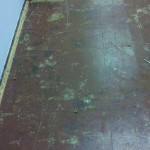Posted by admin under Asbestos, Carcinogen, EPA, Federal OSHA, Hazard Communication, OSHA, Training, Uncategorized
Comments Off on What is disturbance of asbestos?
When training people who work around asbestos I usually discuss the word “disturbance” for a LONG time. The reason is simple. If you avoid “disturbing” it, you avoid most of the health issues.
As most people are aware, asbestos is found in many types of materials. Floor tiles, popcorn ceilings, wall panels, etc.
Disturbance relates to the specific activities you perform AND the type of material the asbestos is in.
If the asbestos containing material (ACM) is non-friable, then in theory, it takes more effort to disturb the asbestos. If the material is friable, well, you need to be REALLY careful. – and in some cases, breathing can disturb it. For example, an electrician who uncovers an ancient acoustical ceiling panel and finds damaged asbestos pipe insulation laying on top of it…is probably already in trouble. He has essentially disturbed friable asbestos by merely moving the panel.
 In contrast, a remodeling company installing a floating laminate hardwood over asbestos 9×9 inch tiles (without damaging them) is [probably*] NOT causing airborne releases of asbestos.
In contrast, a remodeling company installing a floating laminate hardwood over asbestos 9×9 inch tiles (without damaging them) is [probably*] NOT causing airborne releases of asbestos.
Most of the OSHA/EPA asbestos rules hinge on the matrix of the material and the activity you are performing on it. The reason is this is what makes the asbestos fiber airborne.
*the OSHA rules are very specific as to work activity, please do your due diligence.
Posted by admin under Air Monitoring, Asbestos, Building Survey, Hazard Communication, Management
Comments Off on What if you’ve had asbestos exposure?
 Occasionally (actually, far too often), I hear from a subcontractor who was told by the General Contractor (or owner) there is no asbestos onsite. Then, after they have been working for a month they find out it actually IS asbestos, and they were disturbing it. What do you do?
Occasionally (actually, far too often), I hear from a subcontractor who was told by the General Contractor (or owner) there is no asbestos onsite. Then, after they have been working for a month they find out it actually IS asbestos, and they were disturbing it. What do you do?
The first thing to do is stop work. Do not try to clean it up. Call an abatement contractor. They will identify the asbestos onsite, clean it up, and provide an airborne clearance test.
Next, you will need to provide awareness training (or better, let the abatement company provide it). Ideally this will occur on the day you start back working. Train everyone onsite about asbestos.
Finally, you (as the safety manager), need to identify and characterize the exposure to the employees. It should probably be a formal letter written to the owner, general contractor and employees.
Here are some tips on writing the letter:
- include employee names, work hours, type of work, PPE worn, and locations they were working
- describe the asbestos. Amount found, locations, type, estimated amount disturbed.
- describe remedy process and steps taken. Names of GC, owner, abatement company, airborne levels found. Who was trained afterwards.
- describe how things will change in the future. Here’s a tip: Â any building before 1985 WILL have a building survey performed for asbestos….in writing.
Really, one exposure to asbestos is probably* not enough to contract a disease (asbestosis, or mesothelioma). It will take 15-30 years for symptoms to appear. But, it might be worth the “goodwill” to send affected employees into a occupational health doctor for a check up. The physician will reassure the employee and may provide some comfort.
*asbestos is a carcinogen. Greater exposure = greater chance of cancer. no amount is safe.
 In contrast, a remodeling company installing a floating laminate hardwood over asbestos 9×9 inch tiles (without damaging them) is [probably*] NOT causing airborne releases of asbestos.
In contrast, a remodeling company installing a floating laminate hardwood over asbestos 9×9 inch tiles (without damaging them) is [probably*] NOT causing airborne releases of asbestos.